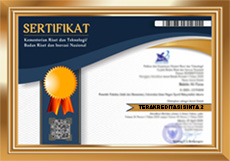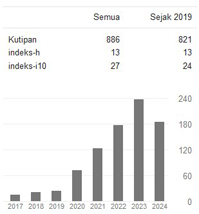Wahyu Alkitabiah dalam Tinjauan Hermeneutika Ricoeur
Abstract
This article attempts to explain the idea of revelation in the Scripture according to Paul Ricoeur's hermeneutic philosophy. This paper consists of two parts. The first part describes the theory of text in Ricoeur's hermeneutics. Ricoeur's most important contributions to this section are his description of threefold semantic autonomy: semantic autonomy with respect to the author's subjective intention outside the text, semantic autonomy with respect to the original cultural context in which the text was written, and semantic autonomy with respect to the original audience or addressee. An important consequence of semantic autonomy is that interpretation of a text is never reproductive but productive. The second part explains that the language of Scripture is much more like poetic language than scientific language. Poetic language is the language of disclosure, which expresses a deeper dimension of reality. The next five literary genres in the Scriptures are discussed, through which divine revelation is expressed: namely, narrative, prophetic, prescriptive, wisdom and hymnic genre. With that Ricoeur shows the richness of biblical revelation in its various dimensions, which together form “a polysemic and polyphonic concept of revelation”.
Keywords: text, discourse, literary genre, semantic autonomy, revelation, narrative, hymnFull Text:
PDFReferences
Aristotle. The Complete Works of Aristotle. Vol. I. Edited with a preface by J. Barnes. Princeton:
Princeton University Press, 1985.
Austin, J.L. How to Do Things with Words. Oxford: Clarendon Press, 1962.
Bachri, Sutardji Calzoum. O, Amuk, Kapak: Tiga Kumpulan Sajak. Jakarta: Penerbit Sinar
Harapan, 1981.
Beardsley, Monroe. Aesthetics: Problems in the Philosophy of Criticism. New York: Harcourt,
Brace and World, 2nd ed. 1981.
Chadman, S. (ed.). Literary Stye: A Symposium. London-New York: Oxford University Press,
Chomsky, Noam. Current Issues in Linguistic Theories. The Hague: Mouton & Co., 1967.
Gadamer, Hans-Georg. Wahrheit und Methode: Grundzüge einer philosophischen Hermeneutik.
Tübingen: Mohr, 2nd ed., 1965. English translation by W. Glen-Doepel and edited by J.
Cumming & G. Barden, Truth and Method. London: Sheed and Ward, 1975, 2nd ed. 1979.
Heidegger, Martin. Sein und Zeit. Tuebingen: Max Niemeyer, zehnte Auflage, 1963.
________. Poetry, Language, Thought. English translation by A. Hofstadter. New York:
Harcourt, Brace and World, 1975.
Hillesum, Etty. Het Verstoorde Leven: Dagboek van Etty Hillesum 1941-1943. Haarlem: De
Haan/Unieboek, 1981. English translation by Arno Pomerans, An Interrupted Life:
The Diaries of Etty Hillesum 1941-1943. New York: Pantheon Books, 1983.
Hjelmslev, Louis. Essais Linguistiques. Copenhagen:Nordisk Sprog-og Kulturfrolag, 1959.
LaCocque, André and Ricoeur, Paul. Thinking Biblically: Exegetical and Hermeneutical
Studies. English translation by David Pellauer. Chicago and London: The Chicago
University Press, 1998.
Niebuhr, H. R. The Meaning of Revelation. New York: The MacMillan, 1960.
Pannenberg, Wolfhart. Revelation as History. New York: The Macmillan Company, 1968.
Ricoeur, Paul. Fallible Man. Translation of L’homme faillible with an introduction by C.A.
Kelbley. Chicago: Henry Regnery, 1965.
___________. “Biblical Hermeneutics”. Semeia. An Experimental Journal for Biblical Criticism
(1975), hlm 27-148.
___________. Interpretation Theory: Discourse and Surplus of Meaning. Preface by T. Klein. Fort
Worth: The Texas Christian University Press, 1976.
___________. The Rule of Metaphor. Translation of La Métaphore vive by R. Czerny, K.
Mclaughlin and J. Costello. London and Henley: Routledge & Kegan Paul, 1978.
___________. The Philosophy of Paul Ricoeur. Edited and prefaced by C.E. Reagan and D. Stewart.
Boston: Beacon Press, 1978.
___________. Essays on Biblical Interpretation. Edited with an introduction by L.S. Mudge.
Philadelphia: Fortres Press, 1980.
___________. Hermeneutics and Human Sciences: Essays on Language, Action and Interpretation.
Edited, translated and introduced by J.B. Thomson. Cambridge: Cambridge University
Press, 1981.
___________. “Life: A Story in Search of a Narrator”. Facts and Values: Philosophical Reflections
from Western and Non-Western Perspectives. Edited by M.C. Doeser and J.N. Kraay.
Dordrecht: Martinus Nijhoff, 1986, hlm. 121-132.
___________. Time and Narrative.Vol.3. Translation of Temps et récit 3 by K. Blamey & D. Pellauer.
Chicago: The University of Chicago Press, 1988.
Schleiermacher, F.D.E. Hermeneutics: The Handwritten Manuscripts. Edited by H. Kimmerle
and translated by J. Duke, & J. Forstman. Missoula: Scholar Press, 1977.
Situmorang, Sitor. Bunga Di Atas Batu. Jakarta: Gramedia, 1989.
Strelka, J.P (ed.). Theories of Literary Genre. University Park: The Pennsylvania State
University Press, 1978.
Van der Weiden, Wim. Seni Hidup: Sastra Kebijaksanaan Perjanjian Lama. Yogyakarta:
Penerbit Kanisius, 1995.
Von Humboldt, Wilhelm. Ueber die Verschiedenheit des menschlichen Sprachbaues.
Herausgegeben und erlaeutert von August F. Pott (Documenta Semiotica).
Hildesheim-New York: Georg OlmsVerlag, 1974.
DOI: http://dx.doi.org/10.31385/jl.v19i2.213.169-184
Refbacks
- There are currently no refbacks.

This work is licensed under a Creative Commons Attribution-NonCommercial-ShareAlike 4.0 International License.

Copyright© 2015 JURNAL LEDALERO This work is licensed under a Creative Commons Attribution-NonCommercial-ShareAlike 4.0 International License.
Institut Filsafat dan Teknologi Kreatif Ledalero Jalan Trans Maumere-Ende - Sikka - Flores - Nusa Tenggara Timur - Indonesia Telp/Fax: 0382 2426535










